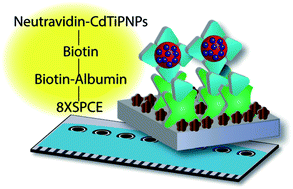Competitive electrochemical biosensing of biotin using cadmium-modified titanium phosphate nanoparticles and 8-channel screen-printed disposable electrodes†
Abstract
In this work, a method for the detection of biotin was developed using a competitive electrochemical biosensor and cadmium-modified titanium phosphate nanoparticles (CdTiPNPs) as detection labels. The electrochemical behaviour of CdTiPNPs was studied and a method for the detection of very low concentrations of these nanoparticles by anodic stripping voltammetry was optimized. After their modification with neutravidin, the nanoparticles were used as labels for the biotin competitive biosensor, which was carried out on the surface of disposable 8-channel screen-printed cards modified with biotinylated albumin. These devices allowed the detection of eight samples simultaneously, and a limit of detection in the order of 1 nM of biotin was obtained. The method was evaluated in real samples by carrying out the determination of biotin in multivitamin tablets. These results show that CdTiPNPs can compete in terms of analytical performance with quantum dots as detection labels, but the methodology is simpler since the typical acid digestion step to release the metals into the solution is not necessary.



 Please wait while we load your content...
Please wait while we load your content...